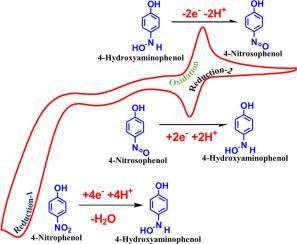增强氧化还原传感揭示CdO@g-C3N4复合材料在碳纸上的电化学电位用于4-硝基苯酚检测
IF 6.3
2区 材料科学
Q2 CHEMISTRY, PHYSICAL
引用次数: 0
摘要
通过简单的湿化学方法合成了一种新型CdO@g-C3N4纳米复合材料,并对其结构和电化学性能进行了深入的研究。FE-SEM和TEM的形貌分析证实了CdO纳米颗粒在g-C3N4纳米片上的均匀分散,形成了良好的异质结构。元素映射和EDX分析显示Cd、O、C和N分布均匀,表明界面相互作用强。XRD和XPS研究证实了复合材料的结晶度和化学稳定性,没有检测到杂质。利用CV和EIS进行的电化学表征显示,电子转移动力学显著增强,电荷转移电阻(Rct)降低了~ 40 Ω,远低于原始CdO (188 Ω)和g-C3N4 (127 Ω)。复合材料表现出清晰的氧化还原峰,对环境污染物4-硝基苯酚(4-NP)具有可逆的电子转移和较强的电催化活性。该传感器线性范围宽(0.1 ~ 100µM),相关系数高(R²= 0.9992),检出限低(2.30µM)。该电极还表现出优异的选择性,能有效区分4-NP及其异构体,并能抵抗普通离子和有机化合物的干扰。长期稳定性测试表明,60个周期后信号保留率超过96%,并且在6天内性能保持一致。自来水、河水和饮用水的实际样品分析回收率在98.8% ~ 99.4%之间,证实了该方法的实用性。这些结果突出了CdO@g-C3N4复合材料作为一种有前途的电化学传感器,具有更高的灵敏度,选择性和稳定性,使其成为针对有害酚类污染物的环境监测应用的有力候选者。本文章由计算机程序翻译,如有差异,请以英文原文为准。

Enhanced redox sensing unraveling the electrochemical potential of CdO@g-C3N4 composite on carbon paper for 4-nitrophenol detection
A novel CdO@g-C3N4 nanocomposite was synthesized via a simple wet-chemical approach and thoroughly investigated for its structural and electrochemical properties. Morphological analysis using FE-SEM and TEM confirmed the uniform dispersion of CdO nanoparticles on g-C3N4 nanosheets, forming a well-integrated heterostructure. Elemental mapping and EDX analysis revealed a homogeneous distribution of Cd, O, C, and N, indicating strong interfacial interaction. XRD and XPS studies confirmed the crystallinity and chemical stability of the composite with no detectable impurities. Electrochemical characterization using CV and EIS revealed significantly enhanced electron transfer kinetics, with a reduced charge transfer resistance (Rct) of ∼40 Ω, much lower than that of pristine CdO (188 Ω) and g-C3N4 (127 Ω). The composite exhibited well-defined redox peaks, demonstrating reversible electron transfer and strong electrocatalytic activity toward 4-nitrophenol (4-NP), a persistent environmental pollutant. The sensor showed a wide linear range (0.1–100 µM), high correlation coefficient (R² = 0.9992), and a low detection limit of 2.30 µM. The electrode also demonstrated excellent selectivity, effectively distinguishing 4-NP from its isomers and resisting interference from common ions and organic compounds. Long-term stability tests showed over 96 % signal retention after 60 cycles and consistent performance over six days. Real-sample analysis in tap water, river water, and drinking water yielded recovery rates between 98.8 % and 99.4%, confirming its practical utility. These results highlight the CdO@g-C3N4 composite as a promising electrochemical sensor, with enhanced sensitivity, selectivity, and stability, making it a strong candidate for environmental monitoring applications targeting hazardous phenolic pollutants.
求助全文
通过发布文献求助,成功后即可免费获取论文全文。
去求助
来源期刊

Surfaces and Interfaces
Chemistry-General Chemistry
CiteScore
8.50
自引率
6.50%
发文量
753
审稿时长
35 days
期刊介绍:
The aim of the journal is to provide a respectful outlet for ''sound science'' papers in all research areas on surfaces and interfaces. We define sound science papers as papers that describe new and well-executed research, but that do not necessarily provide brand new insights or are merely a description of research results.
Surfaces and Interfaces publishes research papers in all fields of surface science which may not always find the right home on first submission to our Elsevier sister journals (Applied Surface, Surface and Coatings Technology, Thin Solid Films)
 求助内容:
求助内容: 应助结果提醒方式:
应助结果提醒方式:


